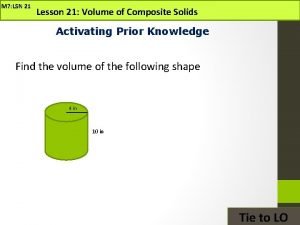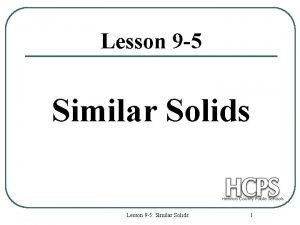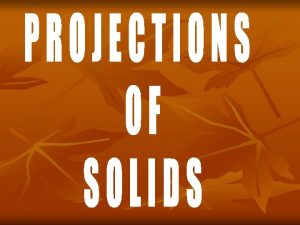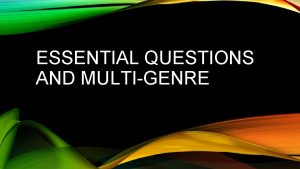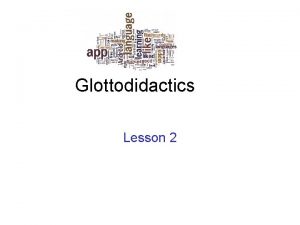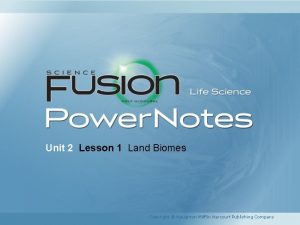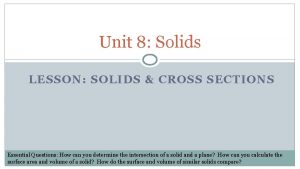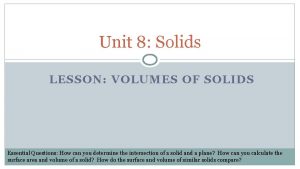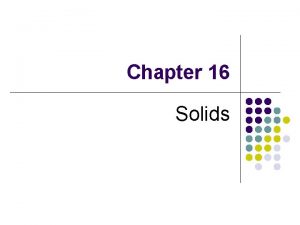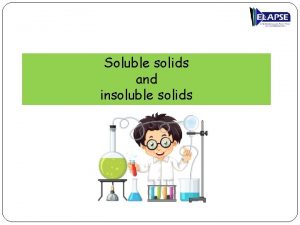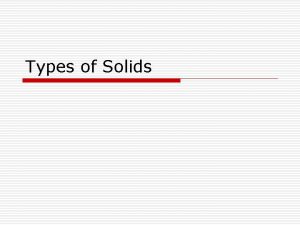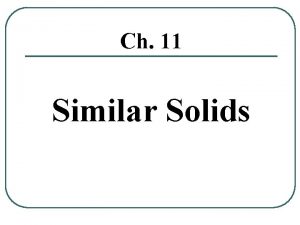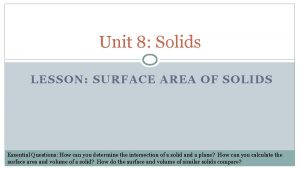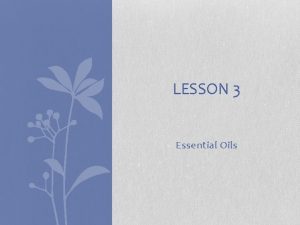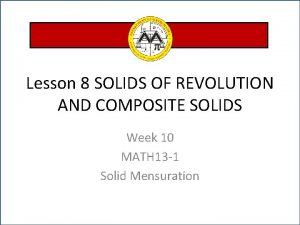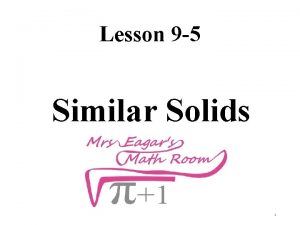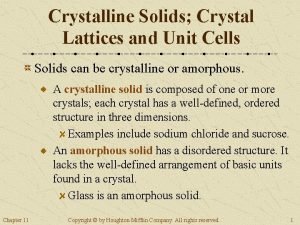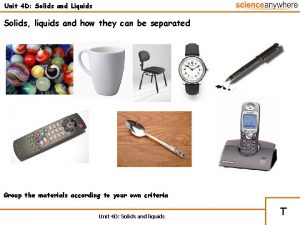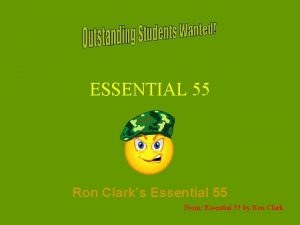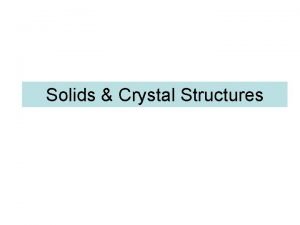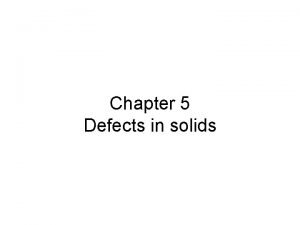Unit 8 Solids LESSON INTRODUCTION TO SOLIDS Essential






















- Slides: 22

Unit 8: Solids LESSON: INTRODUCTION TO SOLIDS Essential Questions: How can you determine the intersection of a solid and a plane? How can you calculate the surface area and volume of a solid? How do the surface and volume of similar solids compare?

Solids Goals: To recognize solids and their parts. To visualize cross sections of solids. Essential Understandings: You can analyze polyhedrons by using relationships between vertices, edges and faces and a sphere by its radius.

Solids The number of edges a polyhedron has is equal to half the sum of the number of sides of all its faces. For example, the polyhedron shown has 7 faces, 2 pentagons and 5 quadrilaterals. Each pentagon has 5 sides while the quadrilaterals have 4. The total number of sides is 5+5+4+4+4=30. 30÷ 2=15, so the polyhedron has 15 edges. Goals: To recognize solids and their parts. To visualize cross sections of solids. Essential Understandings: You can analyze polyhedrons by using relationships between vertices, edges and faces and a sphere by its radius.

Solids Goals: To recognize solids and their parts. To visualize cross sections of solids. Essential Understandings: You can analyze polyhedrons by using relationships between vertices, edges and faces and a sphere by its radius.

Solids Goals: To recognize solids and their parts. To visualize cross sections of solids. Essential Understandings: You can analyze polyhedrons by using relationships between vertices, edges and faces and a sphere by its radius.

Solids Goals: To recognize solids and their parts. To visualize cross sections of solids. Essential Understandings: You can analyze polyhedrons by using relationships between vertices, edges and faces and a sphere by its radius.

Solids Goals: To recognize solids and their parts. To visualize cross sections of solids. Essential Understandings: You can analyze polyhedrons by using relationships between vertices, edges and faces and a sphere by its radius.

Solids Goals: To recognize solids and their parts. To visualize cross sections of solids. Essential Understandings: You can analyze polyhedrons by using relationships between vertices, edges and faces and a sphere by its radius.

Solids Goals: To recognize solids and their parts. To visualize cross sections of solids. Essential Understandings: You can analyze polyhedrons by using relationships between vertices, edges and faces and a sphere by its radius.

Solids Goals: To recognize solids and their parts. To visualize cross sections of solids. Essential Understandings: You can analyze polyhedrons by using relationships between vertices, edges and faces and a sphere by its radius.

Solids Goals: To recognize solids and their parts. To visualize cross sections of solids. Essential Understandings: You can analyze polyhedrons by using relationships between vertices, edges and faces and a sphere by its radius.

Solids Goals: To recognize solids and their parts. To visualize cross sections of solids. Essential Understandings: You can analyze polyhedrons by using relationships between vertices, edges and faces and a sphere by its radius.

Solids Goals: To recognize solids and their parts. To visualize cross sections of solids. Essential Understandings: You can analyze polyhedrons by using relationships between vertices, edges and faces and a sphere by its radius.

Solids Goals: To recognize solids and their parts. To visualize cross sections of solids. Essential Understandings: You can analyze polyhedrons by using relationships between vertices, edges and faces and a sphere by its radius.

Solids Goals: To recognize solids and their parts. To visualize cross sections of solids. Essential Understandings: You can analyze polyhedrons by using relationships between vertices, edges and faces and a sphere by its radius.

Goals: To recognize solids and their parts. To visualize cross sections of solids. Essential Understandings: You can analyze polyhedrons by using relationships between vertices, edges and faces and a sphere by its radius.

Solids Goals: To recognize solids and their parts. To visualize cross sections of solids. Essential Understandings: You can analyze polyhedrons by using relationships between vertices, edges and faces and a sphere by its radius.

Solids Goals: To recognize solids and their parts. To visualize cross sections of solids. Essential Understandings: You can analyze polyhedrons by using relationships between vertices, edges and faces and a sphere by its radius.

Solids Goals: To recognize solids and their parts. To visualize cross sections of solids. Essential Understandings: You can analyze polyhedrons by using relationships between vertices, edges and faces and a sphere by its radius.

Solids Goals: To recognize solids and their parts. To visualize cross sections of solids. Essential Understandings: You can analyze polyhedrons by using relationships between vertices, edges and faces and a sphere by its radius.

Solids Goals: To recognize solids and their parts. To visualize cross sections of solids. Essential Understandings: You can analyze polyhedrons by using relationships between vertices, edges and faces and a sphere by its radius.

Solids � Homework: Worksheet 12. 1 • 1 -3 (pick 2), 4 -6 (pick 2), 7 -9 (pick 2), Do either 10 -13 or 1417, 18 -19 (Pick 1; sketches don’t have to be perfect)
 Lesson 1 thermal energy and the behavior of matter
Lesson 1 thermal energy and the behavior of matter Essential non essential fatty acids
Essential non essential fatty acids Right triangle trigonometry examples
Right triangle trigonometry examples Lesson 21 7.3
Lesson 21 7.3 Similar solids
Similar solids Cone projection of solids
Cone projection of solids Unit 10, unit 10 review tests, unit 10 general test
Unit 10, unit 10 review tests, unit 10 general test Essential questions poetry
Essential questions poetry Lesson outline lesson 3 describing circuits answers
Lesson outline lesson 3 describing circuits answers Lesson outline lesson 3 mountain building answers
Lesson outline lesson 3 mountain building answers Lesson outline lesson 2 aquatic ecosystems answer key
Lesson outline lesson 2 aquatic ecosystems answer key Microteaching plan
Microteaching plan L 101: introduction to health care leadership
L 101: introduction to health care leadership Pati explain to tapi that the beggar
Pati explain to tapi that the beggar Lesson 1 your total health
Lesson 1 your total health Weather forecast lesson 3 outline answers
Weather forecast lesson 3 outline answers Sat vocabulary lesson and practice lesson 4
Sat vocabulary lesson and practice lesson 4 Lesson outline physical properties lesson 2
Lesson outline physical properties lesson 2 Unit 6 lesson 1 climates of the world
Unit 6 lesson 1 climates of the world Lesson outline case study lesson 3
Lesson outline case study lesson 3 Lesson 2 measurement and scientific tools answer key
Lesson 2 measurement and scientific tools answer key Fingerprint galton details
Fingerprint galton details Biome
Biome



